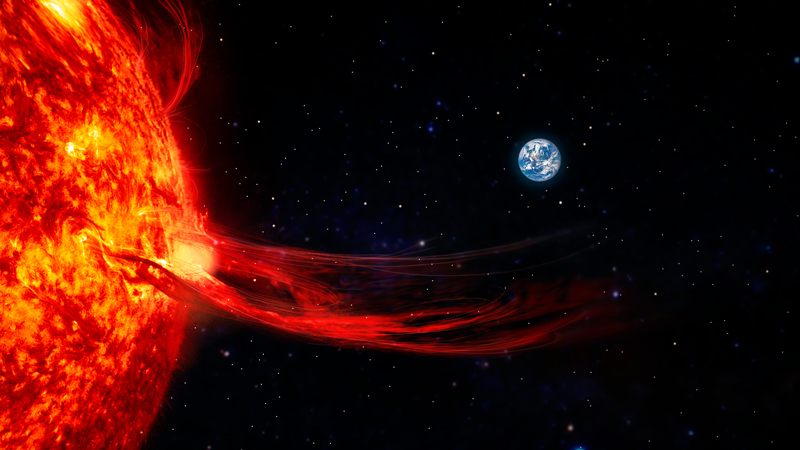Why would anyone intentionally overengineer?
Infrastructure engineers do this all the time. In this arena, requirements are dictated by magnitudes at extremes, rather than the functional needs of normal operation.
Insurance companies exclude buildings in the flood plain, for example. Cities construct their levees and seawalls to exceed the high-water mark of storm tides.
In Florida, state building codes demand new windows and doors withstand Category 4 hurricane wind speeds. In California, structures near fault lines need to be reinforced against seismic hazards.
From the cooling of nuclear power plants to the capacity of storm drains, the structure and performance of infrastructure must match a hypothetical extreme — something that might happen only once in a hundred years.
Here’s the question at hand:
Should we engineer our electronics and electrical equipment the same way?
The Reality of Geomagnetic Weather
In September 1859, a massive solar flare, or coronal mass ejection (CME), generated a powerful geomagnetic storm. The event is named after the British astronomer Richard Carrington, who observed and documented the event.
The solar flare sent a massive burst of solar wind and charged particles hurtling towards Earth, with the energy of a thousand nuclear bombs. When this flare reached our atmosphere, intense auroras on both poles extended much further than usual. The Northern Lights were reported as far south as the Caribbean.
The telegraph system, the most advanced technology of the time for long-distance communication, failed at many points. Telegraph operators received electric shocks, lines overheated from induced current, and offices and equipment caught fire.
Vulnerability of an Interconnected World
It’s important to note that the Carrington Event occurred during a time when electrical and electronic technology was in its infancy. If the storm does not seem terribly destructive, it was because there was not much electrical infrastructure in 1859.
Circumstances have changed. Today we can imagine a sphere of electronic and electrical connections spanning the globe. Almost all economic activity now relies on some form of electronics. A geomagnetic storm of the same magnitude today would likewise disable our communications (both radio frequency and cellular). Because of our connected world, we would lose a great deal more.
Data centers, Internet, most modes of modern transportation, satellites, industry, agriculture, distribution, medicine, water treatment, and so on throughout the economy. Due to the interconnections between systems, even partial disruptions to infrastructure may lead to a collapse of the entire system.
The next Carrington Event would not just cause a few auroras and office fires. It would bring society to a halt, permanently destroy electronic infrastructure, and within weeks, cause the death of millions.
Frequency of Solar Wind Compared to Other Natural Disasters
While the threat of geomagnetic storms could spread disaster across an entire hemisphere, the public is more aware of natural disasters that are more localized, more visible, and more frequent.
To put the probability and impacts into proper perspective, we can compare the historical rate of other natural disasters:
- Volcanos — Large eruptions could be roughly a 10-year event, about 10 times as likely as a consequential geomagnetic storm.
- Cyclones — Infrastructure damage to the United States from hurricane or typhoon landfalls might occur on average 83 times over a decade, according to the National Oceanic and Atmospheric Administration (NOAA) data from 1980 to the present.
- Earthquakes — Quakes of Richter Scale 7.5 or above cause structural damage in cities. The average number of damage-causing earthquakes or tsunamis between 2008-2017 was 56.
- Solar Wind Events — The NOAA Space Weather Prediction Center continuously monitors solar activity and provides forecasts. The frequency of geomagnetic storms is linked to the solar cycle, which has an approximately 11-year period. During periods of high solar activity, geomagnetic storms are more likely to occur.
Conventional wisdom has long considered a major geomagnetic storm a 100-year phenomenon.
A 100-year event is equivalent to 1 percent chance per year, which is 10 percent per decade. New research on solar activity estimated the odds a bit higher than that: 12 percent chance per decade.
Future-Oriented Policies and Engineering
An electromagnetic pulse from solar wind seems like an extremely rare occurrence. However, estimates show it to be less rare than the massive flood predicted on insurance maps.
We should conclude that, like building precautions for hurricanes and earthquakes, policies should be enacted to meet the threat. Governments, businesses, and emergency services should strengthen electric infrastructure and critical electronics. They need to overengineer surge protection with a 100-year event in mind.
Building for natural disasters is a relatively new idea. California did not begin to change its building codes until 1930, decades after the San Francisco quake of 1908. Florida began strengthening structures in 1992. We can see the result in terms of lives saved and damages when comparing more recent disasters. Regions without strengthened infrastructure suffer more.
The reality is that another solar flare reaching Earth is inevitable. The threat must not be underestimated. As our reliance on technology deepens, so does our vulnerability to geomagnetic storms.
By implementing infrastructure hardening, enhancing communication and coordination, ensuring satellite resilience, and fostering emergency preparedness, governments, businesses, and the military can collectively mitigate the impact of HEMP events. A collaborative, multidisciplinary approach is essential to safeguard our digitally connected society from the potentially devastating consequences of geomagnetic storms.



